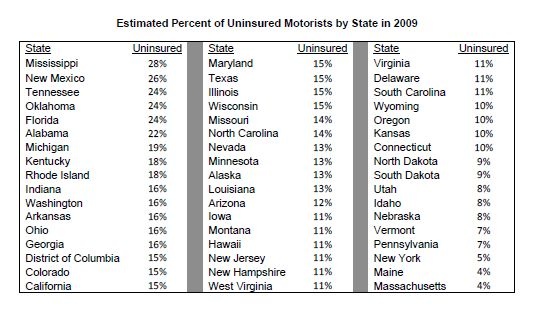
| Monday, May 09, 2011 | Archives | Advertise | Online Buyer's Guide | FLEETSolutions |
Uninsured Motorists Percentage Rises During Recession
"The leveling trend in the percentage of uninsured motorists is an unfortunate consequence of the economic downturn, and illustrates how virtually everyone is affected by recent economic developments," said Elizabeth A. Sprinkel, Senior Vice President of the IRC. "Despite laws in many states requiring drivers to maintain insurance, about one in seven motorists remain uninsured. This forces responsible drivers who carry insurance to bear the burden of paying for injuries caused by drivers who carry no insurance at all."  In a new study, Uninsured Motorists, 2011 Edition, IRC estimates the percentage of uninsured drivers countrywide, and in individual states for 2008 and 2009. The IRC estimates are based on the ratio of uninsured motorist (UM) insurance claim frequency to bodily injury (BI) claim frequency. UM claims are made by individuals who are injured in accidents caused by uninsured drivers. BI claims are made by individuals injured in accidents caused by insured drivers. The magnitude of the uninsured motorist problem varies from state to state. In 2009, the five states with the highest uninsured driver estimates were Mississippi (28 percent), New Mexico (26 percent), Tennessee (24 percent), Oklahoma (24 percent), and Florida (24 percent). The five states with the lowest uninsured driver estimates were Massachusetts (4.5 percent), Maine (4.5 percent), New York (5 percent), Pennsylvania (7 percent), and Vermont (7 percent).  In a previous report, the IRC anticipated a trend reversal in the countrywide estimate of the percentage of uninsured motorists, citing a strong historical relationship between the national unemployment rate, and the national UM to BI ratio. The strength of the historical relationship appears to have diminished slightly with the inclusion of more recent data. The IRC study examines data collected from nine insurers, representing approximately 50 percent of the private passenger auto insurance market in the U.S. |
 |
NAFA Fleet Management Association 125 Village Blvd., Suite 200 Princeton, NJ 08540 Telephone: 609.720.0882 Fax: 609.452.8004 |






